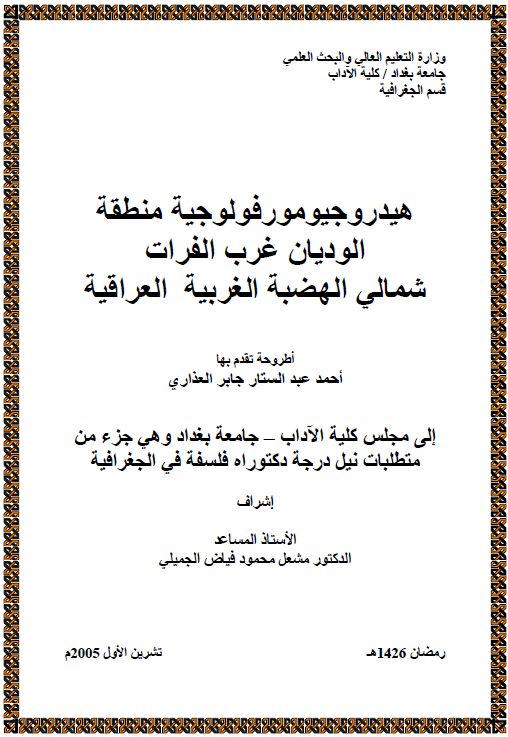هيدروجيومورفولوجية منطقة الوديان غرب الفرات
شمالي الهضبة الغربية العراقية
أطروحة تقدم بها
أحمد عبد الستار جابر العذاري
إلى مجلس كلية الآداب – جامعة بغداد
وهي جزء من متطلبات نيل درجة دكتوراه فلسفة في الجغرافية
وهي جزء من متطلبات نيل درجة دكتوراه فلسفة في الجغرافية
إشراف
الأستاذ المساعد
الدكتور مشعل محمود فياض الجميلي
تعد أحواض منطقة الدراسة والبالغ عددها (74) حوضاً، من أحواض الهضبة الغربية التي تصب أغلبها في نهر الفرات، والتي تجري مع الاتجاه العام للانحدار من الجنوب الغربي والغرب نحو الشمال الشرقي والشرق ( نحو نهر الفرات).
تبلغ مساحة منطقة الدراسة 26.916 ألف كلم2 ، تقع جميع مناطق الدراسة ضمن محافظة الأنبار، وتشمل أجزاء من أربعة أقضية هي (حديثة والقائم وعنه والرطبة)، وتمثل الجزء الشمالي من الهضبة الغربية التي كان يطلق عليها سـابقا ( البادية الشمالية)، وتتدرج هذه الهضبة بالارتفاع من الشرق نحو الغرب والجنوب الغربي، يبلغ أقصى ارتفاع لها(900م)، أما مناخ منطقة الدراسة فهو صحراوي جاف، وتعتمد المياه الجارية في الأحواض والوديان على موسم التساقط وهو فصل الشتاء و غالبا ما يكون متذبذب الأمطار وبالتالي إقتصار جريان المياه خلال الأودية على مدد التساقط المطري.
وتمتاز منطقة الدراسة بوجود طيات وتراكيب خطية كان لها الأثر الكبير على الأشكال الأرضية والعمليات الجيومورفولوجية، مثل طية عنه المحدبة وأثرها على الاحواض المائية وكذلك طية الولج المقعرة وطية الكعرة المقعرة(منخفض الكعرة)، أما التكوينات الصخرية (المكاشف الصخرية) فتتراوح بين أقدم التكاوين في الهضبة الغربية (الكعرة) البيرمي إلى رواسب العصر الرباعي المتمثلة برواسب الوديان والمراوح الغرينية.
وبالاعتماد على المناخ الجاف وقلة التساقط اتسمت المنطقة بقلة الغطاء النباتي بصورة عامة، مع تركز واضح في بطون الوديان والمنخفضات والفيضات وحول آبار المياه والعيون.
كانت أغلب منطقة الدراسة ذات ترب فقيرة من المواد العضوية وضحلة في أجزاء كبيرة من منطقة الدراسة.
وقد صنفت الأشكال الأرضية الموجودة ضمن المنطقة على أساس النشأة أو التكوين إلى عدة أصناف منها، أشكال أرضية بنيوية وأشكال أرضية تعروية وترسيبية مائية وأشكال أرضية تعروية وترسيبية ريحية فضلاً عن الأشكال الكارستية وحركة المواد.
أما أعلى درجة للأحواض فقد بلغت الدرجة السابعة لحوضين رئيسين همــــا (الرطكة وصواب) وقد تباينت الأحواض في مساحاتها وصفاتها المورفومترية تبعاً لعدة عوامل من أهمها التكوين الجيولوجي، تنوع المكاشف الصخرية لهذه المساحة الكبيرة، ساعد على تباين الأحواض في خصائصها المورفومترية بصورة عامة، بالرغم من وجود تشابه في بعض الخصائص.
أما المياه الجوفية فكانت موجودة في ( 9) تكاوين جوفية وأغلبها قليلة الملوحة وهذا دليل على أن المياه هي مياه أمطار متسربة، وأفضلها هي في تكويــــن ( ملوصي) المعلق.
وقد وجدنا علاقة قوية بين الأشكال الأرضية والتكوينات الجيولوجية والخصائص المورفومترية، من كثافة وأطوال وأعداد.
Ministry of Higher Education
and Scientific Research
Baghdad University/ College of Arts
Hydrogeomorphology of Vallies in Western Euphrates - Northern Iraqi Plateau
A Thesis Submitted
Ahmed Abdul Sattar Al- A'athari
To the Council of College of Art / University of Baghdad as a Partial Fulfillment to the Requirements of Ph.D Degree of physical Geography
Supervised by
Assist.Prof.
Dr. Moshaal Mahmood Fai'adh
Al-Jomaily
Abstract
Basins of study Area, (73) basins, are considered of the Iraqi Western Plateau basins that most of which pour into Euphrates river flowing with the general direction of the slope from western south, west toward eastern north and the east (toward Euphrates river).
The study region area is about (26.916) Km2. It lies within Al-Anbar governorate including four districts (Haditha, Qa’im, Aana and Rutba) which represent the northern part of the Western Plateau called earlier (Northern Desert “Badiya Shamaliya”). This plateau height is graded from the east toward the west and the western south till reaching (900) m. the Climate of study area is dry. The flowing waters in the basins or valleys depend on rainfall season, winter that is mostly with vibrating rains. Consequently, water flowing through valleys is confined to rainfall periods.
The study region is characterized with the existence of folds and linear structures that have great influence on land forms and geo-morphological processes, like Aana embossed fold and its effect on water basins, also Al-Wilij depressed fold and Al-Ka’ra depressed fold (Al-Ka’ra depression). Whereas the rocky formations (rocky exposures) is ranging between the most ancient formations in the Western Plateau (Al-Ka’ra) and the Quadra-age represented by valley residues, alluvial ventilators and saturated soils… etc.
Relying on the dry climate and rarity of rainfall, the region is marked with plant green cover generally with a clear concentration in valley interiors, depressions, flood and around water wells and springs.
Most of study region is with poor soils of organic materials and shallow in many parts.
The ground shapes existed within the region are categorized on the basis of evolution and formation into several categories such as; plain, bare, sedimental and aquatic ground shapes and bare, sedimental and windy ground shapes as well as carsic shapes and material motion.
As to the highest degree of basins, it is the seventh degree for two main basins (Rafka and Swab). The basins differ in their areas and morphologic aspects according to several factors. The most important is the geological formation, variety of rocky exposures of this big area although they are similar in some properties.
Whereas the underground waters exist in underground formations with little salinity proving that the waters are drained rain waters, the best of which is the saline formation of Al-Mu’allaq. We have found a strong relation between the ground shapes and geological formations and between geological formations and morphological characteristics in density, lengths and materials.





0 تعليقات
شكرا لتعليقك .. سيتم الرد عليكم في اقرب وقت ممكن .
كوكب المنى